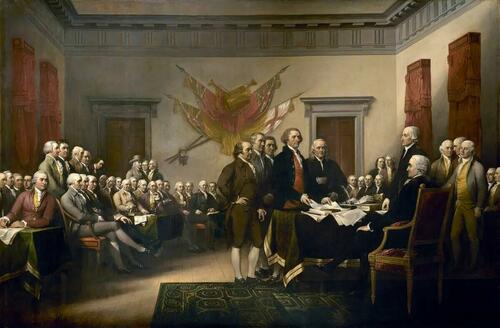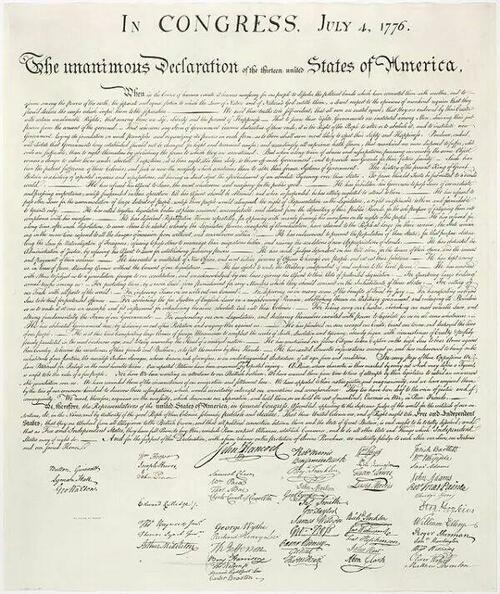
Authored by Joseph Lord via The Epoch Times (emphasis ours),
On July 4, Americans will observe the 248th birthday of the United States.

In 1776, members of the Second Continental Congress gathered in Philadelphia had already made a decision the impact of which would be felt around the world for centuries to come: the collective colonies agreed to declare their independence from Great Britain, at the time the most powerful nation on the planet.
Many people know what happened next.
The document, written by a young and upstart Thomas Jefferson, was officially approved by the Continental Congress.
News of its adoption traveled the breadth of the eastern seaboard, the news slowly and painstakingly making its way to the frontiers.
It reignited the political tensions felt everywhere at the time between loyalists and the patriots clamoring for independence.
Fewer people know about the personal intrigues, motives, and political aspirations of the 56 men who ultimately affixed their name to the document, pledging: “Our Lives, our Fortunes, and our sacred Honor” to a cause that, at the time, may have seemed nearly hopeless.
July 4, 1776, changed the trajectory of world history forever.
On that day the Continental Congress voted to adopt Jefferson’s draft of the Declaration of Independence.
But at the time, it was far from obvious that July 4 would become Independence Day.
July 2 seemed the obvious day for celebration to John Adams.
On that day, the Continental Congress adopted Virginian Richard Henry Lee’s motion officially declaring that the colonies “are, and of right ought to be, free and independent states.”
Writing to his wife, Abigail Adams, Adams famously declared that July 2: “Will be celebrated by succeeding generations as the great anniversary festival.
“It ought to be solemnized with pomp and parade, with shows, games, sports, guns, bells, bonfires, and illuminations, from one end of this continent to the other.”
Of course, it was ultimately the adoption of the Declaration on July 4, and not the July 2 adoption of the resolution that paved its way, that became the United States’ formal Independence Day.
When people think about the Declaration of Independence, they may think of a room of elder statesmen, as depicted in the famous work of artist John Trumbull.

In point of fact, the 56 delegates gathered in Philadelphia in 1776 were younger than this image may suggest, on average clocking in at just 44 years old.
That included a broad range of ages, from 20-somethings to a septuagenarian.
The youngest signatory of the document was South Carolina’s Edward Rutledge, who was just 26 years and 8 months old.
Another South Carolina signatory, Thomas Lynch Jr., was three days shy of his 27th birthday.
A plurality of the signatories, meanwhile, were in their 30s with many others in their early 40s.
Only seven of them, including 70-year-old Benjamin Franklin, the oldest signatory of the declaration, were 60 years of age or older.
While independence may seem in retrospect to be a foregone conclusion, that wasn’t necessarily the case.
Several members of the Continental Congress were skeptical of independence.
Many founders initially took a more moderate stance toward grievances with the home island.
That’s not to say that nobody was thinking about it—the idea was already stirring in coffeehouses and taverns across the colonies, and revolutionary leaders like Adams were outspoken in favor of independence as early as 1774.
By 1775, particularly following the Battles of Lexington and Concord, the idea had been adopted by most congressional leaders.
But some moderates—led by John Dickinson, famous for his “Letters From a Pennsylvania Farmer”—remained skeptical about independence until the eleventh hour.
These included Robert Livingston, one of the most powerful and renowned names in New York who later served a variety of diplomatic roles for the fledgling U.S. government, and John Jay, who later became the first chief justice of the Supreme Court.
The divides were even more pronounced among the people: After the war, Mr. Adams was famously quoted as saying: “One-third of the [American] people were for the Revolution, one-third were against it, and one-third were neutral.”
Of all the signatures attached to the Declaration of Independence, John Hancock’s is perhaps the most famous.
Mr. Hancock was famously unfazed by the risk of being hanged for treason, affixed his name—now the most recognizable signature in American political history—in large characters to the bottom of the Declaration.

What fewer people know are the personal motives that may have influenced this decision.
Prior to the Revolutionary War, Mr. Hancock was one of the most successful smugglers in North America.
His business flourished, in large part, thanks to the phenomenon of “salutary neglect,” during which British agents were lax in their enforcement of customs laws.
But after the end of the French and Indian War in 1763, British coffers were empty.
To refill them, Britain ended the unofficial policy of salutary neglect, coming down hard on smugglers and others trying to evade British customs laws.
Mr. Hancock, as the most successful smuggler in North America, was especially adversely affected by this crackdown, even having his ship—the Liberty—seized by British officials for legal violations.
Thus, for Mr. Hancock, the Revolution represented not only an ideological imperative but a financial one as well.
The Declaration of Independence is today viewed by Americans as a near-sacrosanct document, a founding justification of the core ideals of the new nation founded in 1776.
Today, its words—with their message of “inalienable rights” and “self-evident” truths—are deeply entangled in Americans’ political sense of self and are regularly repeated from presidential stump speeches to the halls of Capitol Hill.
But for all that, it took time for the declaration to become such an important fixture of American life and history.
At the time, it simply made official a revolt against the Crown that was already effectively underway.
After the last signature was affixed in August 1776, the document itself remained in the custody of Congress in Philadelphia, only one of several important documents at the time.
It wasn’t until Jefferson became President Jefferson in 1800—the “Revolution of 1800”—that the document, written by him, began to take pride of place in Americans’ hearts and minds.
That year, the document was moved to the new seat of government in Washington.
Until 1952, it was moved often within the capital, sometimes being held in the Library of Congress, sometimes in the State Department; it was moved twice, during the War of 1812 and again during World War II, for safekeeping.
But since 1952, the document has been prominently displayed in the National Archives, where it remains one of the capital’s most famous attractions.
Authored by Joseph Lord via The Epoch Times (emphasis ours),
On July 4, Americans will observe the 248th birthday of the United States.

In 1776, members of the Second Continental Congress gathered in Philadelphia had already made a decision the impact of which would be felt around the world for centuries to come: the collective colonies agreed to declare their independence from Great Britain, at the time the most powerful nation on the planet.
Many people know what happened next.
The document, written by a young and upstart Thomas Jefferson, was officially approved by the Continental Congress.
News of its adoption traveled the breadth of the eastern seaboard, the news slowly and painstakingly making its way to the frontiers.
It reignited the political tensions felt everywhere at the time between loyalists and the patriots clamoring for independence.
Fewer people know about the personal intrigues, motives, and political aspirations of the 56 men who ultimately affixed their name to the document, pledging: “Our Lives, our Fortunes, and our sacred Honor” to a cause that, at the time, may have seemed nearly hopeless.
July 4, 1776, changed the trajectory of world history forever.
On that day the Continental Congress voted to adopt Jefferson’s draft of the Declaration of Independence.
But at the time, it was far from obvious that July 4 would become Independence Day.
July 2 seemed the obvious day for celebration to John Adams.
On that day, the Continental Congress adopted Virginian Richard Henry Lee’s motion officially declaring that the colonies “are, and of right ought to be, free and independent states.”
Writing to his wife, Abigail Adams, Adams famously declared that July 2: “Will be celebrated by succeeding generations as the great anniversary festival.
“It ought to be solemnized with pomp and parade, with shows, games, sports, guns, bells, bonfires, and illuminations, from one end of this continent to the other.”
Of course, it was ultimately the adoption of the Declaration on July 4, and not the July 2 adoption of the resolution that paved its way, that became the United States’ formal Independence Day.
When people think about the Declaration of Independence, they may think of a room of elder statesmen, as depicted in the famous work of artist John Trumbull.

In point of fact, the 56 delegates gathered in Philadelphia in 1776 were younger than this image may suggest, on average clocking in at just 44 years old.
That included a broad range of ages, from 20-somethings to a septuagenarian.
The youngest signatory of the document was South Carolina’s Edward Rutledge, who was just 26 years and 8 months old.
Another South Carolina signatory, Thomas Lynch Jr., was three days shy of his 27th birthday.
A plurality of the signatories, meanwhile, were in their 30s with many others in their early 40s.
Only seven of them, including 70-year-old Benjamin Franklin, the oldest signatory of the declaration, were 60 years of age or older.
While independence may seem in retrospect to be a foregone conclusion, that wasn’t necessarily the case.
Several members of the Continental Congress were skeptical of independence.
Many founders initially took a more moderate stance toward grievances with the home island.
That’s not to say that nobody was thinking about it—the idea was already stirring in coffeehouses and taverns across the colonies, and revolutionary leaders like Adams were outspoken in favor of independence as early as 1774.
By 1775, particularly following the Battles of Lexington and Concord, the idea had been adopted by most congressional leaders.
But some moderates—led by John Dickinson, famous for his “Letters From a Pennsylvania Farmer”—remained skeptical about independence until the eleventh hour.
These included Robert Livingston, one of the most powerful and renowned names in New York who later served a variety of diplomatic roles for the fledgling U.S. government, and John Jay, who later became the first chief justice of the Supreme Court.
The divides were even more pronounced among the people: After the war, Mr. Adams was famously quoted as saying: “One-third of the [American] people were for the Revolution, one-third were against it, and one-third were neutral.”
Of all the signatures attached to the Declaration of Independence, John Hancock’s is perhaps the most famous.
Mr. Hancock was famously unfazed by the risk of being hanged for treason, affixed his name—now the most recognizable signature in American political history—in large characters to the bottom of the Declaration.

What fewer people know are the personal motives that may have influenced this decision.
Prior to the Revolutionary War, Mr. Hancock was one of the most successful smugglers in North America.
His business flourished, in large part, thanks to the phenomenon of “salutary neglect,” during which British agents were lax in their enforcement of customs laws.
But after the end of the French and Indian War in 1763, British coffers were empty.
To refill them, Britain ended the unofficial policy of salutary neglect, coming down hard on smugglers and others trying to evade British customs laws.
Mr. Hancock, as the most successful smuggler in North America, was especially adversely affected by this crackdown, even having his ship—the Liberty—seized by British officials for legal violations.
Thus, for Mr. Hancock, the Revolution represented not only an ideological imperative but a financial one as well.
The Declaration of Independence is today viewed by Americans as a near-sacrosanct document, a founding justification of the core ideals of the new nation founded in 1776.
Today, its words—with their message of “inalienable rights” and “self-evident” truths—are deeply entangled in Americans’ political sense of self and are regularly repeated from presidential stump speeches to the halls of Capitol Hill.
But for all that, it took time for the declaration to become such an important fixture of American life and history.
At the time, it simply made official a revolt against the Crown that was already effectively underway.
After the last signature was affixed in August 1776, the document itself remained in the custody of Congress in Philadelphia, only one of several important documents at the time.
It wasn’t until Jefferson became President Jefferson in 1800—the “Revolution of 1800”—that the document, written by him, began to take pride of place in Americans’ hearts and minds.
That year, the document was moved to the new seat of government in Washington.
Until 1952, it was moved often within the capital, sometimes being held in the Library of Congress, sometimes in the State Department; it was moved twice, during the War of 1812 and again during World War II, for safekeeping.
But since 1952, the document has been prominently displayed in the National Archives, where it remains one of the capital’s most famous attractions.
Loading…





